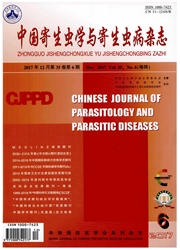

 中文摘要:
中文摘要:
目的观察泡球蚴感染小鼠肝脏中自细胞介素-10(IL-10)和转化生长因子.13(TGF-β1)的动态变化。方法将60只雌性BALB/c小鼠随机均分为实验组和对照组,实验组腹腔注射活原头节悬液0.2ml(约含400个原头节),对照组腹腔注射等量生理盐水,分别于接种后2、8、30、90、180和360d各处死5只小鼠,取肝组织进行病理学检查,并用免疫组织化学法检测肝组织中IL-10和TGF-β1的表达情况。结果实验组小鼠,腹腔和肝小叶出现多处直径不等的小囊泡,随感染时间的延长逐渐增多增大,与周围肝组织分界不明显。HE染色显示,实验组小鼠肝脏出现炎症细胞浸润,泡球蚴纤维囊壁与肝细胞和囊壁之间炎症反应带的形成等不同程度的病理改变:对照组小鼠肝小叶结构完整,偶见少量炎症细胞浸润,肝细胞胞浆疏松化和脂肪变性。实验组小鼠肝组织表达水平随着泡球蚴感染时间的延长而逐渐上升,感染后90d,实验组小鼠肝组织中IL-10和TGF.B1的表达水平均达高峰,细胞阳性率分别为(16.39+1.73)%和(23.69±2.29)%,与对照组比较[(1.09±0.10)%和(0.98±0.09)%1差异均有统计学意义(P〈0.01),而且之后均维持在较高水平。结论小鼠泡球蚴感染中晚期,IL10和TGF-β1表达水平均提高,其免疫抑制作用不利于清除和控制肝脏中泡球蚴。
 英文摘要:
英文摘要:
Objective To observe the dynamic expression and function of IL-10 and TGF-β1 in liver of BALB/c mice infected with Echinococcus multilocularis (Era) . Methods Sixty female BALB/c mice were randomly divided into experiment group and control group. Mice in the experiment group were each injected with 0.2 ml Em protoscolex suspension (containing about 400 protoscoleces) , while those in control group received same volume of normal saline. At 2, 8, 30, 90, 180, and 360 d after infection, 5 mice from each group were sacrificed and liver specimens were collected for pathological examination and immunohisiochemical detection for IL-10 and TGF-β1. Results In mice of the experiment group, Em cysts in different sizes were found in the abdominal cavity and the liver tissue, which gradually enlarged with the time. HE staining showed infiltration of lymphocytes in liver tissue, pathological change between the cyst wall and hepatic cells. In the control the liver lobules showed integrity and inflammatory cells were seen occasionally. The level of IL-10 expression in liver tissue of the infected mice increased with the time, and reached a peak [(16.39±1.73) %] at 90 d post-infection and maintained a high level thereafter. The expression of TGF-β1 also reached the highest level [(23.69±2.29) %] . Both were significantly higher than the control (P〈0.01) , though a low level expression was found in the control at 90d post-injection. Conclusion The expressions of IL-10 and TGF-β1 both increase in the middle and late stages of the infection. Besides, their inhibited functions do not be helpful for clearing and controlling Echinococcus multilocularis infection in livers.
 同期刊论文项目
同期刊论文项目
 同项目期刊论文
同项目期刊论文
 The prediction of T- and B-combined epitope and tertiary structure of the Eg95 antigen of Echinococc
The prediction of T- and B-combined epitope and tertiary structure of the Eg95 antigen of Echinococc 期刊信息
期刊信息
